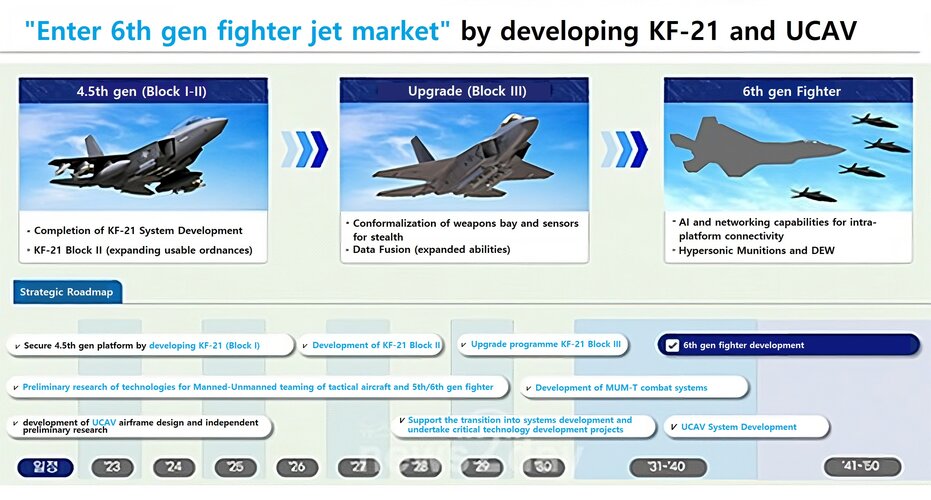Inlate/Intake design is very crucial since it is about the flow of air into propulsion.
J20
Check J31
AMCA
TFX
VS KF21 Inlet/Intake
Right and Left from the top
----------------------------------------
Most modern passenger and military aircraft are powered by
gas turbine engines, which are also called jet engines. There are several different
types of gas turbine engines, but all turbine engines have some
parts in common. All turbine engines have an
inlet to bring
free stream air into the engine. The inlet sits upstream of the
compressor and, while the inlet does no work on the flow,
inlet performance has a strong influence on engine net
thrust. As shown in the figures above, inlets come in a variety of shapes and sizes with the specifics usually dictated by the speed of the aircraft.
SUBSONIC INLETS
For aircraft that cannot go faster than the
speed of sound, like large airliners, a simple, straight, short inlet works quite well. On a typical
subsonic inlet, the surface of the inlet from outside to inside is a continuous smooth curve with some thickness from inside to outside. The most upstream portion of the inlet is called the
highlight, or the inlet
lip. A subsonic aircraft has an inlet with a relatively thick lip.
SUPERSONIC INLETS
An inlet for a
supersonic aircraft, on the other hand, has a relatively sharp lip. The inlet lip is sharpened to minimize the performance losses from
shock waves that occur during supersonic flight. For a supersonic aircraft, the inlet must slow the flow down to subsonic speeds before the air reaches the compressor. Some supersonic inlets, like the one at the upper right, use a central cone to shock the flow down to subsonic speeds. Other inlets, like the one shown at the lower left, use flat hinged plates to generate the compression shocks, with the resulting inlet geometry having a rectangular cross section. This
variable geometry inlet is used on the F-14 and F-15 fighter aircraft. More exotic inlet shapes are used on some aircraft for a variety of reasons. The inlets of the
Mach 3+ SR-71 aircraft are specially designed to allow
cruising flight at high speed. The inlets of the SR-71 actually produce thrust during flight.
HYPERSONIC INLETS
Inlets for
hypersonic aircraft present the ultimate design challenge. For
ramjet-powered aircraft, the inlet must bring the high speed external flow down to subsonic conditions in the
burner. High stagnation temperatures are present in this speed regime and variable geometry may not be an option for the inlet designer because of possible flow leaks through the hinges. For
scramjet-powered aircraft, the heat environment is even worse because the flight Mach number is higher than that for a ramjet-powered aircraft. Scramjet inlets are highly integrated with the fuselage of the aircraft. On the X-43A, the inlet includes the entire lower surface of the aircraft forward of the cowl lip. Thick, hot
boundary layers are usually present on the compression surfaces of hypersonic inlets. The flow exiting a scramjet inlet must remain supersonic.
INLET EFFICIENCY
An inlet must operate efficiently over the entire flight envelope of the aircraft. At very low aircraft speeds, or when just sitting on the runway, free stream air is pulled into the engine by the compressor. In England, inlets are called
intakes, which is a more accurate description of their function at low aircraft speeds. At high speeds, a good inlet will allow the aircraft to maneuver to high
angles of attack and sideslip without disrupting flow to the compressor. Because the inlet is so important to overall aircraft operation, it is usually designed and
tested by the airframe company, not the engine manufacturer. But because inlet operation is so important to engine performance, all engine manufacturers also employ inlet aerodynamicists. The amount of disruption of the flow is characterized by a numerical
inlet distortion index. Different airframers use different indices, but all of the indices are based on ratios of the local variation of pressure to the average pressure at the compressor face.
The ratio of the average total pressure at the compressor face to the free stream total pressure is called the
total pressure recovery.
Pressure recovery is another inlet performance index; the higher the value, the better the inlet. For hypersonic inlets the value of pressure recovery is very low and nearly constant because of
shock losses, so hypersonic inlets are normally characterized by their kinetic energy efficiency. If the airflow demanded by the engine is much less than the airflow that can be captured by the inlet, then the difference in airflow is spilled around the inlet. The airflow mis-match can produce
spillage drag on the aircraft.




























